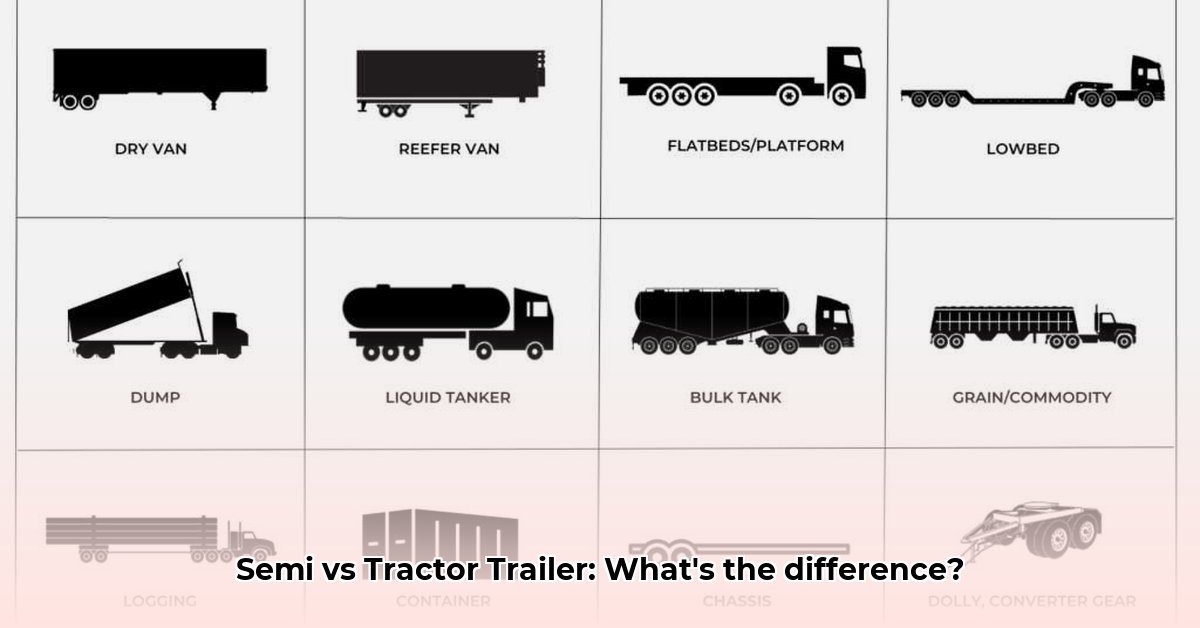
Ever wondered about the difference between a semi-truck and a tractor-trailer? Many use the terms interchangeably, but there's a crucial distinction. This guide clarifies the differences, covering everything from their physical components and weight capacities to the licenses needed to operate them and the logistical implications of understanding these distinctions. For a deeper dive, check out this helpful resource on tractor vs trailer.
Understanding the Components: Tractor and Trailer
The terms "semi-truck" and "tractor-trailer" are often confused. A semi-truck is often used informally to refer to the entire vehicle. However, it's more accurate to consider a tractor (also known as a "truck tractor" or "cab") as the power unit – the engine, cab, and components that propel the vehicle. It pulls the load but doesn't carry cargo itself. The trailer is the cargo-carrying unit – the part that holds the goods. A tractor-trailer refers to the complete combination of tractor and one or more trailers.
The Crucial Connection: Fifth Wheel and Kingpin
The tractor and trailer are connected by a fifth wheel, a robust, semi-circular device mounted on the tractor, which acts as a hitch. It connects to the kingpin, a large pin extending upwards from the trailer's front. This system is designed for exceptional strength, crucial for transporting heavy loads.
Exploring Trailer Types: A Variety of Applications
Different trailers are designed for specific cargo:
- Dry Van Trailers: Enclosed trailers for general cargo needing protection from the elements.
- Refrigerated Trailers (Reefers): Temperature-controlled trailers for perishable goods.
- Flatbed Trailers: Open trailers for oversized or irregularly shaped cargo.
- Tanker Trailers: Designed for transporting liquids or gases in bulk.
Choosing the right trailer is vital for efficient and safe transport.
Licensing Requirements: CDL Classes
Operating a tractor-trailer requires a Commercial Driver's License (CDL). The class needed depends on the vehicle's size and weight:
- Class A CDL: For vehicles exceeding 26,000 pounds Gross Vehicle Weight Rating (GVWR). Most tractor-trailer combinations require this license.
- Class B CDL: For vehicles under 26,000 pounds GVWR towing a trailer.
- Class C CDL: For smaller vehicles, typically under 26,000 pounds GVWR, often without towing large trailers.
State regulations may vary slightly.
Legal and Safety Considerations: Regulations for Heavy Vehicles
The trucking industry is heavily regulated for safety. Weight limits are strictly enforced; exceeding these is illegal and dangerous. Hours-of-service regulations restrict driving time to combat driver fatigue. Regular vehicle maintenance and safety inspections are paramount.
Logistical Impact: Planning and Optimization
Understanding the differences between tractors and trailers is vital for efficient logistics. Accurate weight calculations are necessary for safe route planning, avoiding weight restrictions. Trailer selection directly impacts transportation costs and efficiency.
Practical Applications: Real-World Implications
Choosing the right trailer type and understanding weight limits are crucial for efficient operations and legal compliance. Incorrect choices can lead to delays, damage, and legal issues. Selecting the appropriate trailer significantly impacts fuel consumption and overall transportation costs.
Key Differences Summarized
| Feature | Tractor | Trailer |
|---|---|---|
| Primary Function | Provides power; pulls the trailer | Carries the cargo |
| Weight Capacity | Varies; depends on engine size | Varies greatly depending on type and size |
| Cargo Area | None | Dedicated to cargo; type and size vary greatly |
| Coupling | Fifth wheel | Kingpin |
This guide highlights the key distinctions between semi-trucks and tractor-trailers. While the terms are often used interchangeably, understanding their nuances is essential for safe and efficient transportation.
Key Takeaways:
- The terms "semi-truck" and "tractor-trailer" are frequently confused, yet denote distinct parts of a heavy-duty trucking operation.
- Understanding these differences is essential for efficient logistics, regulatory compliance, and safe operation.
- Various trailer types cater to specific cargo needs making the right choice critical for successful transportation.
- CDL classes determine the types of vehicles an individual can legally operate.